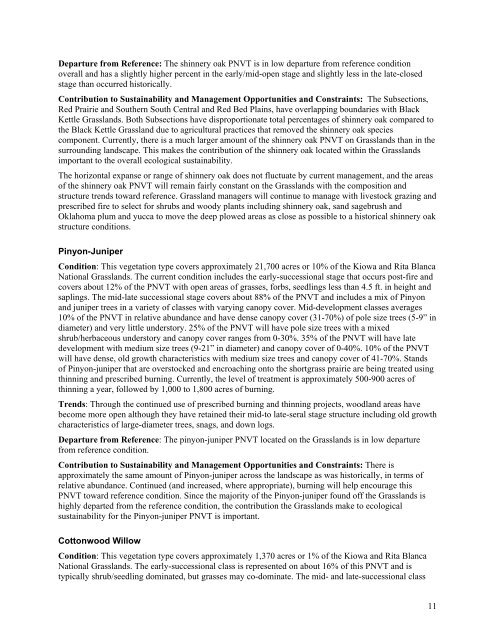Comprehensive Evaluation Report
Comprehensive Evaluation Report
Comprehensive Evaluation Report
Create successful ePaper yourself
Turn your PDF publications into a flip-book with our unique Google optimized e-Paper software.
Departure from Reference: The shinnery oak PNVT is in low departure from reference condition<br />
overall and has a slightly higher percent in the early/mid-open stage and slightly less in the late-closed<br />
stage than occurred historically.<br />
Contribution to Sustainability and Management Opportunities and Constraints: The Subsections,<br />
Red Prairie and Southern South Central and Red Bed Plains, have overlapping boundaries with Black<br />
Kettle Grasslands. Both Subsections have disproportionate total percentages of shinnery oak compared to<br />
the Black Kettle Grassland due to agricultural practices that removed the shinnery oak species<br />
component. Currently, there is a much larger amount of the shinnery oak PNVT on Grasslands than in the<br />
surrounding landscape. This makes the contribution of the shinnery oak located within the Grasslands<br />
important to the overall ecological sustainability.<br />
The horizontal expanse or range of shinnery oak does not fluctuate by current management, and the areas<br />
of the shinnery oak PNVT will remain fairly constant on the Grasslands with the composition and<br />
structure trends toward reference. Grassland managers will continue to manage with livestock grazing and<br />
prescribed fire to select for shrubs and woody plants including shinnery oak, sand sagebrush and<br />
Oklahoma plum and yucca to move the deep plowed areas as close as possible to a historical shinnery oak<br />
structure conditions.<br />
Pinyon-Juniper<br />
Condition: This vegetation type covers approximately 21,700 acres or 10% of the Kiowa and Rita Blanca<br />
National Grasslands. The current condition includes the early-successional stage that occurs post-fire and<br />
covers about 12% of the PNVT with open areas of grasses, forbs, seedlings less than 4.5 ft. in height and<br />
saplings. The mid-late successional stage covers about 88% of the PNVT and includes a mix of Pinyon<br />
and juniper trees in a variety of classes with varying canopy cover. Mid-development classes averages<br />
10% of the PNVT in relative abundance and have dense canopy cover (31-70%) of pole size trees (5-9” in<br />
diameter) and very little understory. 25% of the PNVT will have pole size trees with a mixed<br />
shrub/herbaceous understory and canopy cover ranges from 0-30%. 35% of the PNVT will have late<br />
development with medium size trees (9-21” in diameter) and canopy cover of 0-40%. 10% of the PNVT<br />
will have dense, old growth characteristics with medium size trees and canopy cover of 41-70%. Stands<br />
of Pinyon-juniper that are overstocked and encroaching onto the shortgrass prairie are being treated using<br />
thinning and prescribed burning. Currently, the level of treatment is approximately 500-900 acres of<br />
thinning a year, followed by 1,000 to 1,800 acres of burning.<br />
Trends: Through the continued use of prescribed burning and thinning projects, woodland areas have<br />
become more open although they have retained their mid-to late-seral stage structure including old growth<br />
characteristics of large-diameter trees, snags, and down logs.<br />
Departure from Reference: The pinyon-juniper PNVT located on the Grasslands is in low departure<br />
from reference condition.<br />
Contribution to Sustainability and Management Opportunities and Constraints: There is<br />
approximately the same amount of Pinyon-juniper across the landscape as was historically, in terms of<br />
relative abundance. Continued (and increased, where appropriate), burning will help encourage this<br />
PNVT toward reference condition. Since the majority of the Pinyon-juniper found off the Grasslands is<br />
highly departed from the reference condition, the contribution the Grasslands make to ecological<br />
sustainability for the Pinyon-juniper PNVT is important.<br />
Cottonwood Willow<br />
Condition: This vegetation type covers approximately 1,370 acres or 1% of the Kiowa and Rita Blanca<br />
National Grasslands. The early-successional class is represented on about 16% of this PNVT and is<br />
typically shrub/seedling dominated, but grasses may co-dominate. The mid- and late-successional class<br />
11
















